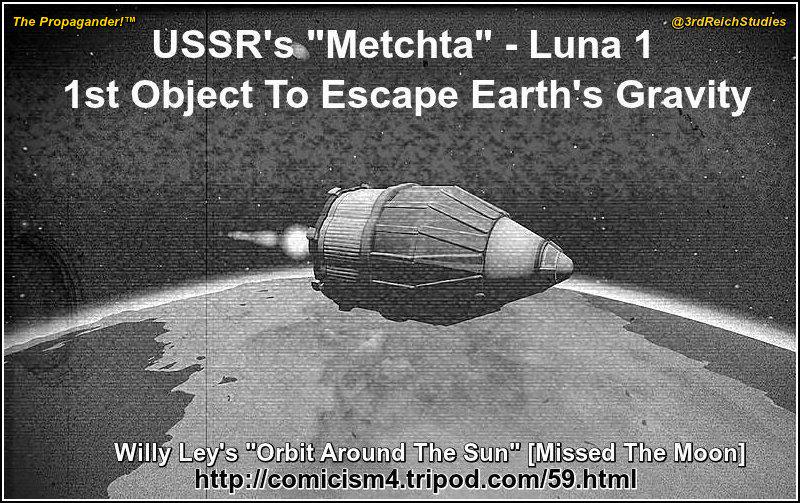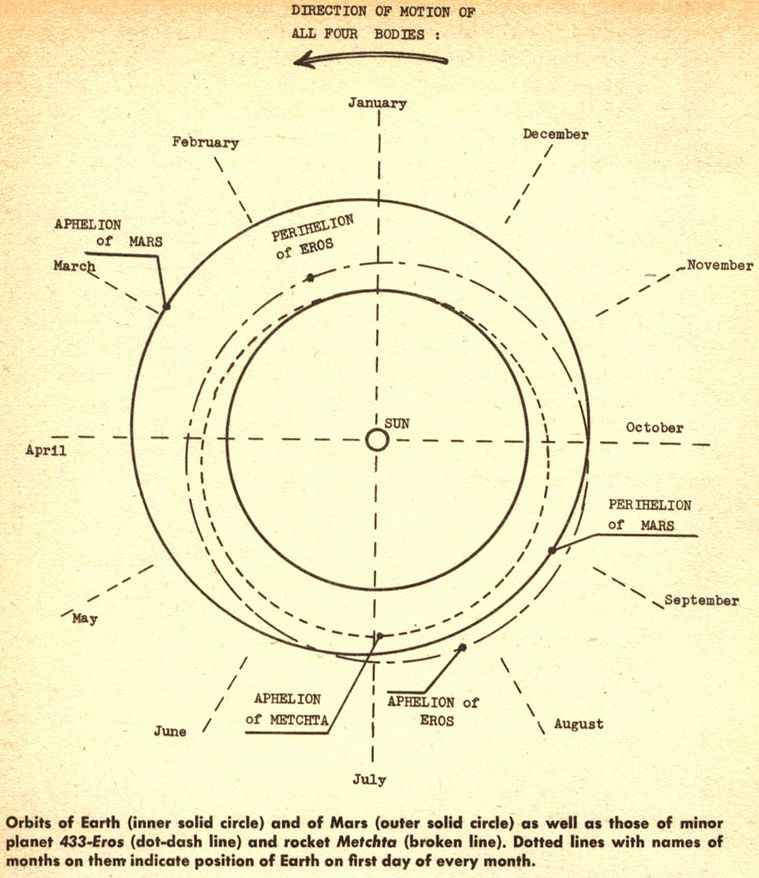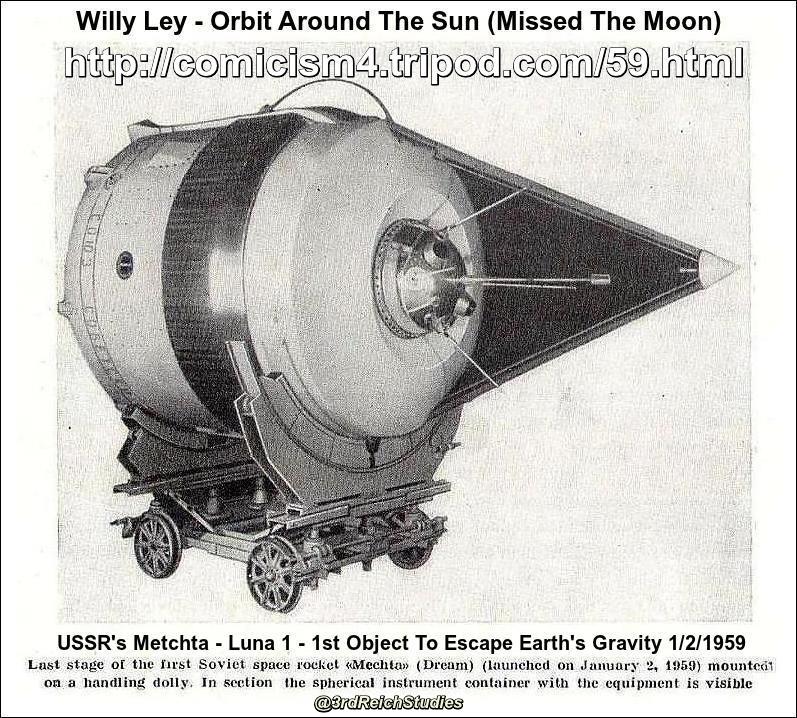


The question that came most frequently to me during January and the early part of February, by mail, by phone and in person after lectures, was one that surprised me very much. It was usually phrased as follows: "How do we know that the Russian rocket which missed the Moon is really in orbit around the Sun?" The answer I gave was more or less that the Russian rocket had to be in orbit around the Sun because it had no choice.
Most of the time, a blank stare was all I got for this answer, but occasionally somebody wanted to know why the rocket did not melt from the heat if it was in orbit around the Sun.
Careful cross-questioning made it clear to me that the people who wondered what would happen to the rocket in orbit around the Sun had something like a tight orbit in mind. Also, some seem to have been honestly convinced, incredible as it may sound, that the Moon and the Sun are both far from the Earth in space, but that they are pretty close to each other.
The whole story obviously needs some explanation and clarification. Probably all readers of GALAXY do not need the explanation itself, but they can use this column as ammunition if they have to explain the whole thing to others.
The explanation has to begin with a few simple figures about the orbit of the Earth. Most books state that the mean distance of the Earth from the Sun is 93 million miles, which is correct, provided the little word "mean" is not overlooked. In reality, the distance varies from 91.5 million miles at perihelion to 94.5 million miles at aphelion. Our Earth goes through perihelion (the point of its orbit closest to the Sun) very early in January, while the aphelion (the point farthest from the Sun) is passed very early in July of each year. The mean orbital velocity of the Earth is 18.5 miles per second.
One rather important point which is not mentioned at all as a rule is that the "dawn side" of the Earth leads as the Earth goes around the Sun. The point which happens to have dawn at the moment is "in front" while the antipodal point is trailing. This is of major importance when it comes to the movements of things fired from Earth. A rocket taking off vertically at dawn will add its own velocity to the orbital velocity of the Earth. A rocket taking off vertically at dusk will subtract its own velocity from the orbital velocity of the Earth.
Now remember that every planet has just the necessary orbital velocity to keep it in its own orbit. If a rocket is fired "ahead" of the planet, it is "too fast" for the planet's orbit around the Sun. Consequently it will start drifting away from the Sun — in other words, it takes on an orbit which is larger than the orbit of the planet from which it was fired. As the rocket drifts away from the Sun, its velocity diminishes, and after some time the Sun's gravitational field wins out and the rocket will approach the Sun again.
During this approach, its velocity increases so that, when it gets back to the orbit of the planet from which it was fired, it is again "too fast" for that particular orbit and it swings outward, away from the Sun, again.



I hope you have looked at the diagram in the meantime (Fig. 1). It shows the orbits of Earth and Mars, of asteroid 433-Eros and of Metchta drawn to scale. It can be seen that the orbit of the rocket crosses neither the orbit of Mars nor the orbit of Eros. It will come considerably closer to both than the Earth does, of course. The closest possible approach between Earth and Eros is 14 million miles.
Metchta and Eros can, theoretically, come as close as about eight million miles. Likewise, Metchta could come as close to Mars as about 20 million miles. These two "abouts" with reference to the closest approach are due to the fact that the orbit of Metchta is not yet definitely established.
Even if the rocket's instruments were still reporting, the orbit into which Metchta was thrown is not particularly good, as regards possible astronomical results. Personally I have the feeling that the Russians counted on hitting the Moon.
The reason for this opinion is this: Normally one would expect to miss and it would then be a most interesting experiment to see over what distance signals from the rocket can still be received. Signals over a distance of a million miles are very likely. Beyond that, one would have to see.
It would be only logical, therefore, to equip such a rocket with as much battery power as possible, so that the signal will be broadcast for as long as possible. But the batteries of Metchta went dead quite soon after the rocket passed the Moon. This is why I think the Russians counted on a hit.
Before I say something about the future of Metchta, I have to make one more remark about the diagram. If the rocket had been somewhat faster, its orbit might extend out far enough to touch the orbit of Mars. How close to Mars could it come in this case? The answer is that there would still be nearly three million miles between the rocket and the planet, because the rocket travels in the plane of the Earth's orbit around the Sun.
This is not the same as the plane of the orbit of Mars — the two are inclined to each other, and at the distance of Mars, the planes of the two orbits are that far apart from each other.
Well, Metchta is now in orbit around the Sun, without the slightest danger of being melted. The orbital period is 447 days or just about 15 months. After 15 months, the rocket will be in Earth's orbit at the point where Earth is in early January. But fifteen months from the firing date, Earth will be three months farther along in its orbit — it will just have passed the "March 1 line." In other words, Earth will be farther and farther from the place where Metchta touches Earth's orbit; Earth will have crossed the "June 1 line" the next time Metchta comes to Earth's orbit, and so forth.
Later on, of course, they come closer together again, and during the winter of 1963-1964, something may happen. We don't know yet what it will be. The rocket needs four times 447 days or 1788 days for four complete revolutions. The Earth needs five times 365 VA days or 182 7 VA days to complete five revolutions. The difference is just about 40 days, which is to say that Earth will reach a specific point in its orbit 40 days later than the rocket does. But, as the diagram shows, the two orbits lead into each other very gradually.
During that winter, the rocket will be rather close to Earth for some time. Naturally Earth's gravity will go to work on it. It is most unlikely that the rocket will be forced to re-enter the atmosphere and burn up. But it is likely that it will be forced into a new orbit by the Earth then. Since the Earth will be, so to speak, behind the rocket, the rocket will be slowed down.
This should result in another orbit that is smaller than the one traveled by the rocket right now. But this is as much as can be said at the moment.
— Willy Ley
 Back To:
Back To:Twitter: @3rdReichStudies




Disclaimer: The Propagander!™ includes diverse and controversial materials--such as excerpts from the writings of racists and anti-Semites--so that its readers can learn the nature and extent of hate and anti-Semitic discourse. It is our sincere belief that only the informed citizen can prevail over the ignorance of Racialist "thought." Far from approving these writings, The Propagander!™ condemns racism in all of its forms and manifestations.
Fair Use Notice: The Propagander!™may contain copyrighted material the use of which has not always been specifically authorized by the copyright owner. We are making such material available in our efforts to advance understanding of historical, political, human rights, economic, democracy, scientific, environmental, and social justice issues, etc. We believe this constitutes a "fair use" of any such copyrighted material as provided for in section 107 of the US Copyright Law. In accordance with Title 17 U.S.C. Section 107, the material on this site is distributed without profit to those who have expressed a prior interest in receiving the included information for research and educational purposes. If you wish to use copyrighted material from this site for purposes of your own that go beyond 'fair use', you must obtain permission from the copyright owner.